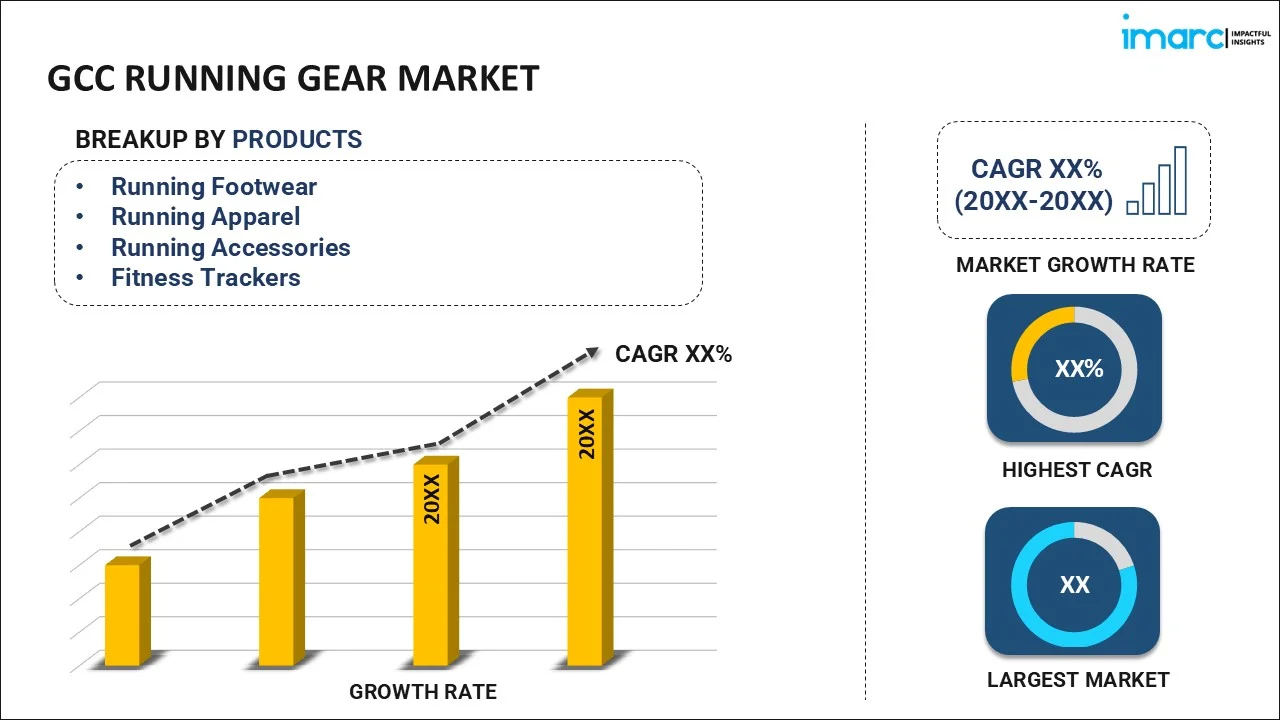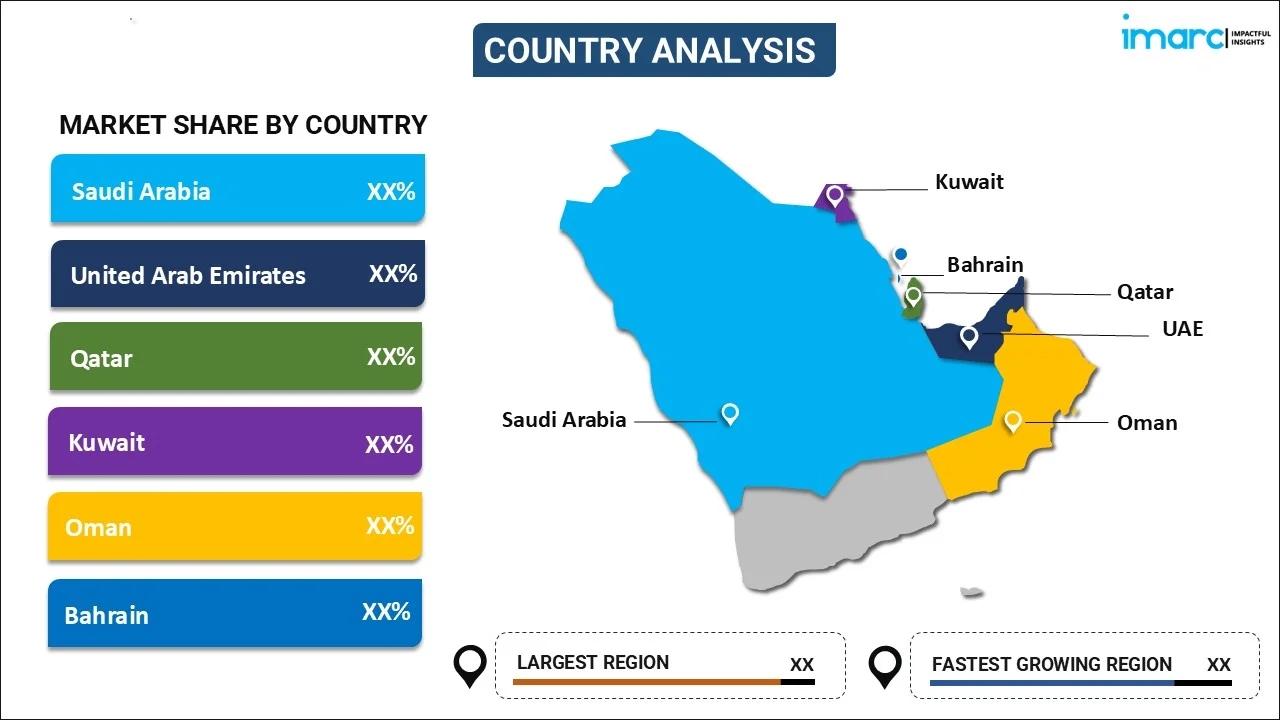
GCC Running Gear Market Report by Product (Running Footwear, Running Apparel, Running Accessories, Fitness Trackers), Gender (Male, Female, Unisex), Distribution Channel (Specialty and Sports Shops, Supermarkets and Hypermarkets, Department and Discount Stores, Online, and Others), and Country 2025-2033
Market Overview:
The GCC running gear market size reached USD 940 Million in 2024. Looking forward, IMARC Group expects the market to reach USD 1,570 Million by 2033, exhibiting a growth rate (CAGR) of 5.56% during 2025-2033.
|
Report Attribute
|
Key Statistics
|
|---|---|
|
Base Year
|
2024
|
|
Forecast Years
|
2025-2033
|
|
Historical Years
|
2019-2024
|
|
Market Size in 2024
|
USD 940 Million |
|
Market Forecast in 2033
|
USD 1,570 Million |
| Market Growth Rate 2025-2033 | 5.56% |
Running gear refers to accessories and devices worn by individuals while running or performing sports-related activities. They include athletic wear products, such as running shoes, jackets, belts, socks and gloves. These products consist of a protective layer to prevent injuries and provide adequate air circulation to the wearer during running or fitness training. The products, such as gloves and jackets, are skin fit and fabricated by water-resistant and scratch-resistant materials to minimize skin chafing and penetration of rain and wind. Athletes and runners also use wearable devices, such as smartwatches and heart rate monitors, for tracking and monitoring their progress.
The widespread acceptance of running as an effective form of physical exercise in maintaining a healthy lifestyle is one of the key factors driving the market growth. With the sedentary lifestyles and hectic schedules, individuals are increasingly adopting running and other high-intensity activities, thereby enhancing the demand for various running gear products. Furthermore, various product innovations, such as the development of high-quality fabrics with aesthetically appealing designs, are providing a boost to the market growth. Other factors, including increasing product premiumization and aggressive promotional activities by the product manufacturers through social media platforms, are anticipated to drive the market further.
Key Market Segmentation:
IMARC Group provides an analysis of the key trends in each sub-segment of the GCC running gear market report, along with forecasts at the regional and country level from 2025-2033. Our report has categorized the market based on product, gender and distribution channel.
Breakup by Product:

- Running Footwear
- Running Apparel
- Running Accessories
- Fitness Trackers
Breakup by Gender:
- Male
- Female
- Unisex
Breakup by Distribution Channel:
- Specialty and Sports Shops
- Supermarkets and Hypermarkets
- Department and Discount Stores
- Online
- Others
Breakup by Country:

- Saudi Arabia
- UAE
- Qatar
- Oman
- Kuwait
- Bahrain
Competitive Landscape:
The competitive landscape of the industry has also been examined along with the profiles of the key players.
Report Coverage:
| Report Features | Details |
|---|---|
| Base Year of the Analysis | 2024 |
| Historical Period | 2019-2024 |
| Forecast Period | 2025-2033 |
| Units | Million USD |
| Segment Coverage | Product, Gender, Distribution Channel, Country |
| Countries Covered | Saudi Arabia, UAE, Qatar, Oman, Kuwait, Bahrain |
| Customization Scope | 10% Free Customization |
| Post-Sale Analyst Support | 10-12 Weeks |
| Delivery Format | PDF and Excel through Email (We can also provide the editable version of the report in PPT/Word format on special request) |
Key Questions Answered in This Report
The GCC running gear market was valued at USD 940 Million in 2024.
We expect the GCC running gear market to exhibit a CAGR of 5.56% during 2025-2033.
The rising adoption of running and other high-intensity fitness activities, along with the introduction of superior-quality fabrics with aesthetically appealing designs, is primarily driving the GCC running gear market.
The sudden outbreak of the COVID-19 pandemic has led to the changing consumer inclination from conventional brick-and-mortar distribution channels towards online retail platforms for the purchase of running gear.
Based on the product, the GCC running gear market can be segregated into running footwear, running apparel, running accessories, and fitness trackers. Currently, running footwear holds the majority of total market share.
Based on the gender, the GCC running gear market has been bifurcated into male, female, and unisex, where male currently exhibits a clear dominance in the market.
Based on the distribution channel, the GCC running gear market can be categorized into specialty and sports shops, supermarkets and hypermarkets, department and discount stores, online, and others. Among these, specialty and sports shops account for the largest market share.
On a regional level, the market has been classified into Saudi Arabia, UAE, Qatar, Oman, Kuwait, and Bahrain.
Need more help?
- Speak to our experienced analysts for insights on the current market scenarios.
- Include additional segments and countries to customize the report as per your requirement.
- Gain an unparalleled competitive advantage in your domain by understanding how to utilize the report and positively impacting your operations and revenue.
- For further assistance, please connect with our analysts.
 Request Customization
Request Customization
 Speak to an Analyst
Speak to an Analyst
 Request Brochure
Request Brochure
 Inquire Before Buying
Inquire Before Buying




.webp)




.webp)












